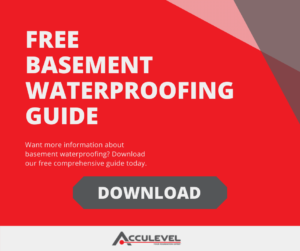The Best Methods for Basement Leak Repair
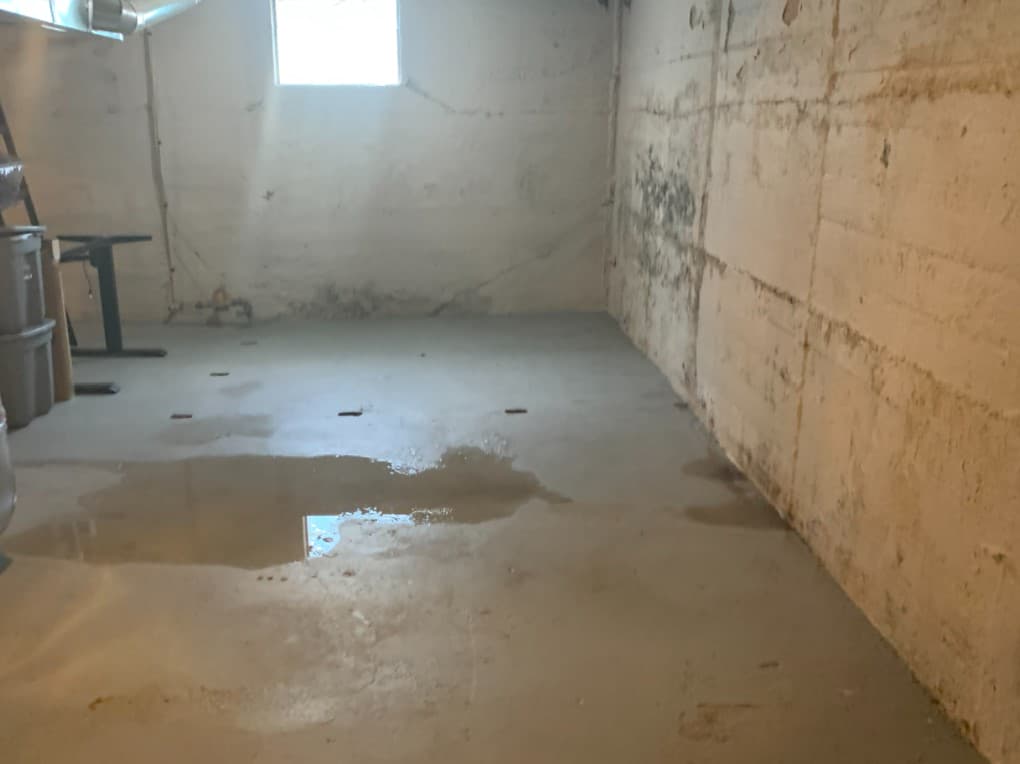
Published 1/19/22, updated 7/14/23
No one likes finding a leak in their basement. It’s a universally unpleasant discovery. In fact, there’s only one thing that makes it worse: you find the leak by stepping in it while wearing socks. There’s something deeply unsettling about soggy wet fabric stuck to your feet — it prompts the bravest of us to curl our toes and rip off our socks with disgust.
Once you’ve removed your soggy footwear and taken a good look at your wet basement, you think to yourself, “now what?!”
The first thing you need to do is identify the source of the water. If it’s coming from a pipe, a shut-off valve, or connection to an appliance, you’re going to need a plumber. However, if the water is coming from the basement walls or floor, you’ll want to hire someone who specializes in foundation repair and/or basement waterproofing.
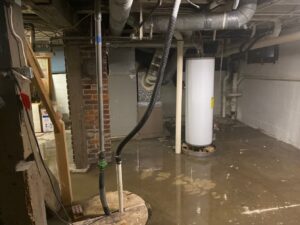 This photo was taken by an Acculevel customer; this situation prompted them to call us for a permanent fix to their leaky basement!
This photo was taken by an Acculevel customer; this situation prompted them to call us for a permanent fix to their leaky basement!
Acculevel is a family-owned and operated company that has been repairing foundations and waterproofing basements since we opened our doors in 1996. During our decades of service, we’ve helped more than 35,000 homeowners repair and restore their homes to full health and stability. We focus on providing whole-home solutions, addressing both the symptoms and the cause of the damage.
In this blog, we’re going to discuss the types of basement leaks, what causes them, and the best methods to repair and address basement leaks.
Does Your Basement Flood When It Rains?
This may seem obvious, but stick with us for a moment. If you only have water intrusion during major rain events, the problem could be outside your basement.
There are ways you can reduce the amount of water near your foundation, and these will help protect your foundation, too!
4 Ways You Can Prevent Water Entering Your Basement
- Landscaping: Evaluate the flowerbeds and borders around your home; make sure they’re set up in a way that allows for water flow. Some border materials are non-porous or dense enough to trap water and create puddles that seep down to the foundation wall and create leaks.
- Grading: This part goes hand-in-hand with a landscaping evaluation. Walk out into your yard, then look at your home; the ground should slope gradually down and away from your foundation. Is the grading still intact? Or has it eroded? Make sure rainwater is being directed away from your foundation.
- Guttering: You should check your guttering at least twice a year to clear out any dirt, leaf litter, or similar debris. A clogged gutter can cause water to overflow and pour water into your landscape.
- Downspouts (aka gutter extensions): Your gutters should direct and drain water into the yard, away from the foundation of your home. Acculevel recommends downspouts to empty rainwater at least 10 feet out into your yard. Do you need downspout extensions? We believe extensions are necessary for every home (the article includes a video tutorial).
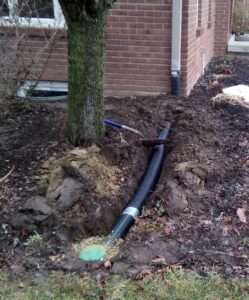
This photo was taken by an Acculevel crew member while installing a downspout extension at a customer’s home.
Does Your Basement Leak When It’s Not Raining?
If you have a wet basement when it’s not actively raining — or if the DIY methods we recommended above don’t solve the problem — you’re going to need waterproofing or encapsulation.
Hydrostatic Pressure Is Causing Your Basement Water Problems
You may have heard the term hydrostatic pressure before because it’s often discussed in the same breath as wet basements. This pressure develops when there is more water in the ground than the soil can absorb. If you put a sponge in a bucket of water, the sponge will soak up some of the water. But what happens to the excess? It doesn’t magically vanish; it’s left in the bucket to freely slosh around.
This is true of the excess groundwater in your yard — nothing stops it from moving except your home. When water finds an obstacle that blocks its movement, it begins to pool up and create pressure. Eventually, the water permeates your home’s foundation.
If you have expansive soil (clay-based) or live in an area with a high water table, you’re more likely to have problems with hydrostatic pressure. This is because the soil is naturally damp from nearby bodies of water. Heavy rain and seasonal flooding add to this, creating more pressure than your foundation can endure.
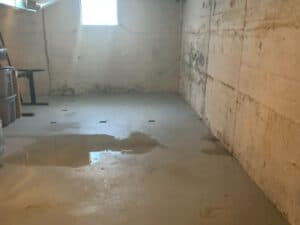
This photo was taken by an Acculevel project advisor during a free in-home assessment.
Water intrusion caused by this pressure can happen anywhere: basement walls, floor, or the cove joint where they meet (like the photo above). The best way to address these kinds of basement leaks is through waterproofing.
Interior Waterproofing Reduces Basement Leaks
We strongly recommend an interior drainage system over exterior waterproofing, as there is a dramatic difference in repair times, costs, and disruption of property (We compare interior versus exterior drainage systems in this blog.)
Please understand that waterproofing is not recommended solely to address water intrusion. It will also relieve hydrostatic pressure that could be damaging your foundation. We’ll talk more about crack repairs later in this article, but keep in mind that the saturated soil surrounding your house is capable of causing major structural damage in addition to a leaking basement.
What’s Involved in Waterproofing a Basement?
Interior basement waterproofing requires two components: a drainage system and a sump pump. The original poured concrete floor is removed around the perimeter of your basement, and the drain tile is placed on top of (or next to) your foundation’s footing. Once the drainage is installed, new concrete is poured over the top of it to restore your basement floor.
The drain tile collects water as it comes through the foundation and directs it to the “pit” where the sump pump is installed. This sump pump then empties the water out of your basement through a discharge line. This line releases the water a safe distance away from the foundation.
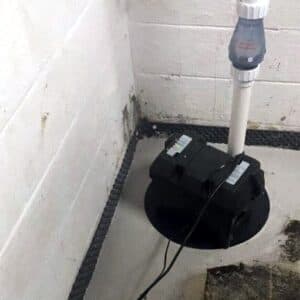 This photo was taken by an Acculevel team member after installing water drainage under the basement floor and directing it to the sump pump pit.
This photo was taken by an Acculevel team member after installing water drainage under the basement floor and directing it to the sump pump pit.
Additional Leak Repairs May Be Necessary
Depending on how and where the water seepage occurs, you may need to take additional steps.
If water builds up under your house, you may need to add drainage lines across the basement floors to prevent puddles or cracks from forming. This drainage can usually be routed to the same sump pump pit to drain away.
However, if you have water leaking through a basement wall at multiple points, you may need encapsulation. We often recommend this additional step if your foundation is built out of brick or stone because these materials and the mortar that connect them are more porous than concrete. Encapsulation is especially necessary if you want to “finish” your basement and use part of it as living space.
Encapsulation Expands Waterproofing
When you encapsulate a basement, a specialized liner is applied to the walls from floor to ceiling. It needs to be made of inorganic material so that it doesn’t support mold growth. It also needs to be waterproof and securely attached to the top of the basement walls.
There should be a slight gap allowed between the liner and the wall. This gap allows water to penetrate through the foundation, but the liner stops it from escaping into your home. Instead, the liner traps the water and directs it down into the drainage track. This liner is the barrier between the damp wall and the finishing materials like insulation, drywall, wooden joists, etc.
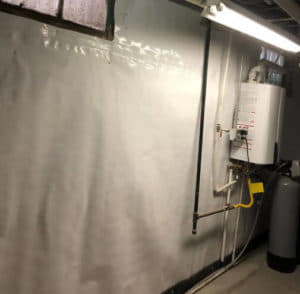 This photo was taken by an Acculevel team member. Water drainage and encapsulation have been installed.
This photo was taken by an Acculevel team member. Water drainage and encapsulation have been installed.
A Dehumidifier is the Last Step
You will also need to install a dehumidifier to control the moisture level inside the basement. Encapsulation will stop water or moisture from coming into your basement. It does not inhibit or prevent condensation from forming inside your home. Condensation is caused by the temperature difference between the inside and outside of your home.
It may seem like condensation is a minor problem, but even this small amount of excess moisture can feed biological growth, which can have a significant negative impact on your home’s air quality. A dehumidifier is an excellent way to prevent harmful microbes and particles from developing and creating health risks for you and your family.
Basement Leak Repair: Cracks, Both Big and Small
As we referenced earlier, hydrostatic pressure is the most common cause of foundation cracks. These cracks don’t always include water intrusion at the start, but as the cracks widen, water becomes inevitable — along with bits of soil, leaf debris, etc.
How Do You Fix Small Basement Cracks?
If the crack is thin and only allows a small amount of water to intrude, epoxy fill is the ideal solution. We recommend this repair method because it has consistently provided the best results for us and our customers.
Unlike other sealants and injection methods, the epoxy we use has a certain amount of flexibility to it. This means that when your foundation expands and contracts with the seasons, the epoxy can also shift to accommodate these changes.
At Acculevel, crack repairs include a 5-year warranty, and epoxy fill has been the most effective and long-lasting repair option. While it’s a strong color (see below), the epoxy fill can also be painted over if you would like to make the repairs to your basement walls less noticeable.
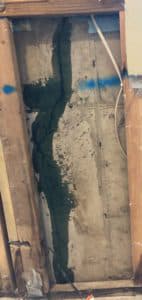
This photo was taken by an Acculevel team member after repairs. Drywall was removed in the finished basement to gain access to the basement leak.
How Do You Repair Larger Basement Leaks?
You might expect that a larger crack will allow more water to intrude into your basement. But this isn’t always the case. Sometimes, large cracks develop without letting in any water at all. It depends on where these cracks form and when. However, even when dry, a large crack in your basement can be a major threat to your home’s overall health.
We’re not talking about thin, wandering cracks in this instance. These larger cracks tend to form in specific shapes. If your basement wall has developed a long horizontal crack, even if it’s not leaking, you need this assessed promptly. The same risk level is true for stair-step or zig-zag cracks.
Generally speaking, poured concrete foundation walls only develop long horizontal cracks. A concrete or cinder block wall can develop either horizontal or stair-step ones because the cracks can follow along the mortar joints.
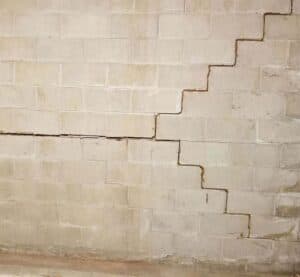
This photo was taken by an Acculevel project advisor during a free estimate. The foundation wall has both types of cracks: horizontal and zig-zag.
Regardless of the foundation material, larger cracks should be treated with urgency. This foundation damage is a sign that your basement wall is beginning to bow or lean inward. Bowing walls need a far more structural type of repair method than a straightforward epoxy fill.
Bowing Walls Are A Structural Issue
If one or more of your basement walls are bowing or leaning inward less than 2 inches, carbon fiber straps are the best option for you and your home. These repairs can also be painted over to minimize their appearance once thoroughly cured and dry. When installed by a qualified foundation contractor, carbon fiber straps should be a permanent solution. At Acculevel, we warranty this repair type for the life of your home’s structure.
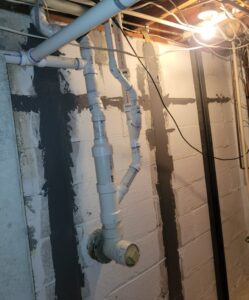
This photo was taken by an Acculevel team member after both epoxy repairs and carbon fiber straps were completed.
Want to Learn More About Basement Waterproofing?
Please use our homeowner’s guide to basement waterproofing. This free resource includes common signs of water damage, the value of downspout extensions, the difference between drainage tile and a French drain, the costs for waterproofing and encapsulation, and many other frequently asked questions.
Do you need more information about the types of cracks you may see in your foundation? This article explains the three major types of foundation cracks, how urgently they need to be repaired, and more resources for each one.
Would You Like a Professional Assessment of Your Basement?
It’s important that you work with a reputable foundation or basement waterproofing contractor who is properly insured and accredited by the Better Business Bureau. Not sure how to determine if a business is the right fit for you? Use our checklist of questions to ask a contractor, which provides both the right questions to ask and when you should be cautious of a certain type of response.
If you live in Indiana or the surrounding areas, call Acculevel. We have an A+ rating with the BBB, treat every home as if it were our own, and focus on providing whole-home solutions for our customers. We believe that a proper solution addresses both the symptoms you’ve noticed as well as the condition(s) that are creating symptoms.
If it’s after business hours, or you would prefer written communication, complete our online form instead! We’ll schedule an appointment for you with one of our knowledgeable and experienced project advisors. They will meet with you to discuss your concerns, evaluate your home, and then carefully review the best options and repair methods to meet your goals and needs.
